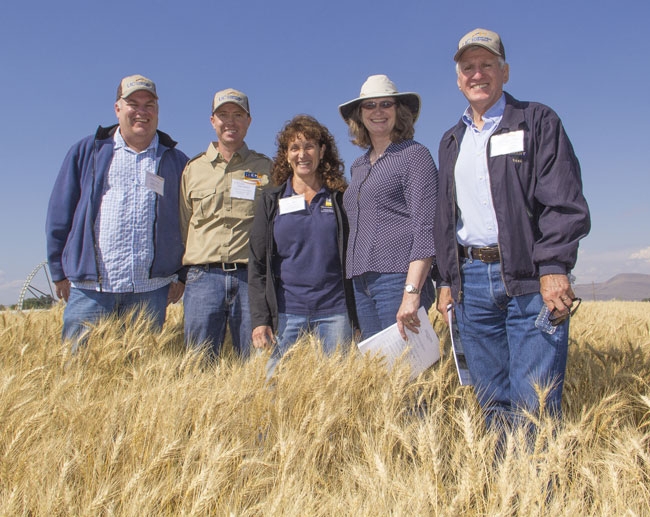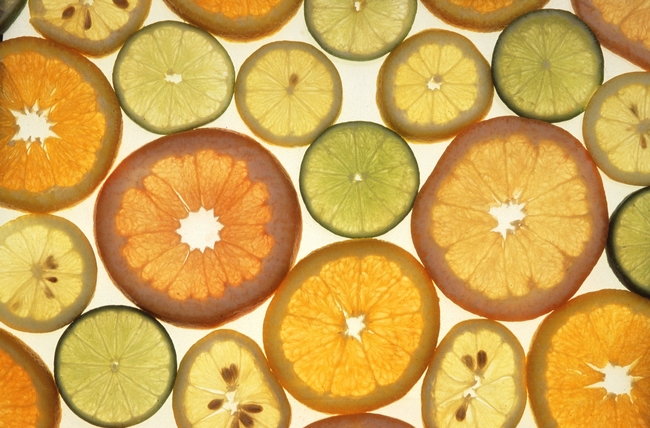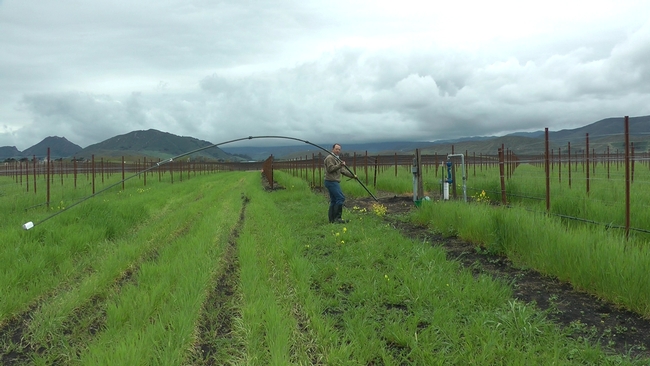Posts Tagged: frost
UC research center in Tulelake commemorates UCCE centennial
The annual field day at the UC Intermountain Research and Extension Center held last week provided an opportunity to mark the 100th anniversary of UC Cooperative Extension with leaders of the organization, reported Todd Fitchette in Western Farm Press.
The research activities at the Intermountain center, situated near the California-Oregon border in Tulelake, focus on peppermint, horseradish, small grains, wheat, potatoes, alfalfa and onions. At the field day, UCCE researchers discussed the progress of alfalfa production in the Klamath Basin, suppressing white rot disease in processing onions, maximizing profitability of wheat, pest management in peppermint and other topics.
The Intermountain Research and Extension Center is one of nine centers under the UC Division of Agriculture and Natural Resources (ANR). The 140-acre facility provides UCCE advisors and specialists the space and support needed to conduct agricultural research in a high mountain interior valley climate zone.
Farmers, backyard gardeners brace for freeze
A very cold airmass from western Canada is moving into California tonight, reported the National Weather Service. With a hard freeze forecast, farmers and backyard gardeners are advised to prepare for temperatures that could damage their plants, reported the Sacramento Bee.
Homeowners should check for plants that are likely to be exposed to cold temperatures, said Judy McClure, UC Cooperative Extension master gardener coordinator.
“The lower spots in the garden tend to get colder than higher spots,” she said. “The bottom of the slope will be colder.”
McClure advises having a good supply of covers. She recommends against throwing a plastic tarp over trees, unless there is a frame to keep the plastic from direct contact with the tree. Contact with the plastic could cause damage by burning the foliage, she explained.
If the soil is dry, McClure said, it is best to water trees and succulents before covering them with blankets or frost cloths. When covering citrus trees, make sure the cover reaches the ground, she said.
The Fresno Bee reported that private meteorologist Steve Johnson has been tracking the approaching weather system since Nov. 25.
"The trajectory keeps it over land and it dries out," Johnson said. "This kind of thing doesn't happen very often. The pattern is very similar to what we saw in December 1998 and 1990."
For more on freeze protection from UC Cooperative Extension, review the following links:
- Citrus freeze protection (home)
- Methods of frost protection (orchards)
- Protecting avocados from frost
UCCE retirements receive news coverage
The wave of UCCE advisors and specialists retiring at the end of June has surfaced concern among people in the agricultural industry.
In the August edition of Wines & Vines, Cliff Ohmart writes about “The Future of Farm Extension.” Ohmart writes: “Given what appears to be a decline in the number of advisors in the future, I am very concerned about their ability to continue being effective in this role. This is no criticism of the hard-working and talented people currently in viticulture advisor positions—or future advisors—but an observation about the workload they currently have and the increased workload that is likely in the future.”
Jim Gordon, editor of Wines & Vines, asks in his August editor’s letter “Will the UC Extension Rebound?” Gordon interviewed Bill Frost, UC associate director of Cooperative Extension and the Agricultural Experiment Station.
“The ANR leadership is firmly committed to putting resources into new positions,” Frost said. Things are happening fast, Frost said, with a little industry help and more importantly with a stabilized state budget. “Under vice president of ANR Barbara Allen-Diaz, it is by far the most aggressive hiring I’ve seen in 20 years.”
In this week’s Capital Press article “Wave of UC farm advisors' retirements continues,” Tim Hearden writes: “Allen-Diaz said the UC is committed to rebuilding the Cooperative Extension's ranks. Since the beginning of 2012, the university has hired 46 extension advisors and specialists across the state, and the UC is on track to hire another 27 advisors by the end of 2014, she said.”
Although ANR has hired 46 new UCCE advisors and specialists in the past 19 months, it is more noticeable when more than 20 of them leave at the same time. To call attention to ANR’s hiring, Bill Frost has begun tweeting whenever a new advisor or specialist signs. If you’d like to follow Bill on Twitter, his handle is @wefrost.
UC study shows promise for protecting coastal winegrapes from frost
In California’s coastal winegrape-growing regions, a spring freeze can be devastating. Tender shoots and leaves burn back, causing damage that reduces the crop yield when it is harvested many months later.
“We’ve had some very severe frosts in San Luis Obispo County and on the Central Coast over the years,” said Mark Battany, UC Cooperative Extension advisor in San Luis Obispo and Santa Barbara counties. “In 2011 we had the most severe frost in 30 years and many millions of dollars of crop and wine value were lost because of that freeze.”
Farmers take various measures to protect their crops when temperatures dip below freezing, such as mowing or tilling the vineyard row middles, or running sprinklers with water pumped from underground aquifers or diverted from streams.
“Sprinkler frost protection is very effective in many areas,” Battany said. “The concern we have in California is that water is becoming more limited. We don’t have the ability to easily import water from other areas to our coastal regions, and our local supplies are being stretched quite thin.”
Some farmers are considering wind machines, which mix warmer air high above the ground with air closer to the ground to raise the temperature. But wind machines are expensive, and the potential effectiveness depends on the strength of the temperature inversion. UC scientists are now gathering data to help inform farmers before making the costly investment.
Battany and his colleagues - Rhonda Smith, UCCE advisor in Sonoma County, Richard Snyder, UCCE specialist in the Department of Land, Air and Water Resources at UC Davis, and Gwen Tindula, UCCE staff research associate - are collecting temperature inversion data at different locations in 60 coastal vineyards throughout three counties to document inversions during frost events.
The scientists installed 35-foot-high meteorological towers with data loggers at the top and at the five-foot height to measure the difference in temperature. In the first year of the study, there were useful inversion conditions on nearly three-fourths of the nights when there was frost.
“That’s a fairly good success rate,” Battany said. “The wind machine will provide quite a bit of protection under those conditions.”
The study will continue this year and in 2014. Farmers who wish to install their own meteorological towers with data loggers can do so at a cost of about $250 each. Installation instructions and specifications are available on the UCCE website.
The UCCE research is funded with a grant from the American Vineyard Foundation and a CDFA Specialty Crops Block Grant.
For more details, see the video below:
That liquid gold called honey
If those pollen-packing honey bees were to board an aircraft, they’d be charged for their carry-on luggage.
Fortunately they don’t and they’re not.
And if we were a bee, we’d have to visit two million flowers to make a pound of honey.
Fortunately we’re not, and we don’t.
The honey bee, brought to America by the European colonists in the 1600s, will be celebrated on National Honey Bee Awareness Day, Saturday, Aug. 21, but this insect should be celebrated every day of the year.
Revered for her indispensable pollination services, she also provides us with that liquid gold we call honey. Wonderful, delectable, soothing honey.
“Honey is nature’s miraculous food,” write Ron Fessenden and Mike McInnes, co-authors of the 215-page book, Honey Revolution: Restoring the Health of Future Generations.
“The nutritional composition of honey, calorie for calorie, is closer to fruit than it is to table sugar, high fructose corn syrup or any other sweetener."
They call it “sunshine energy” and “nature’s soul food.”
Over at the Harry H. Laidlaw Jr. Honey Bee Research Facility, University of California, Davis, pop. 6 million (honey bees, that is), the faculty and staff call this insect simply “amazing.”
This week the UC Davis beekeepers are extracting honey — uncapping the combs with an electric knife, spinning the frames through the centrifugal-force honey extractor, and then gathering the flow of honey.
“It’s a sticky situation,” agreed staff research associate Elizabeth Frost, as Bryce Sullivan, a UC Davis senior majoring in biochemical engineering, and Brandon Seminatore, a UC Davis junior majoring in biochemistry and molecular biology, extracted honey — amid a few bee escapees.
The finished product is perfect for pouring on pancakes and waffles. The National Honor Board provided these recipes that kids of all ages love:
Honey Raspberry Citrus Slush
1-1/2 cups fresh orange juice
1/2 cup honey
2 tablespoons lemon juice
2 tablespoons lime juice
1-1/2 cups raspberries, fresh or frozen
1 cup crushed ice
Lemon or lime for garnish
In a blender, combine orange juice, honey, lemon and lime juices; mix until honey is dissolved. Add raspberries and ice; puree. Serve in beverage glasses garnished with a lemon or lime wheel. Makes six six-ounce servings.
Fruity Honey Yogurt Pops
1 cup fresh nectarines, pineapple or strawberries, chopped
1-1/2 cups plain yogurt
1/3 cup of honey
1 teaspoon vanilla
Eight 3-ounce paper cups and popsicle sticks or plastic spoons
In a blender, combine all ingredients; mix well. Pour evenly into eight paper cups; insert popsicle stick or plastic spoon in center of each. Freeze 4 hours or until frozen solid. Makes 8 pops.

Frame of Uncapped Honey

Sampling





